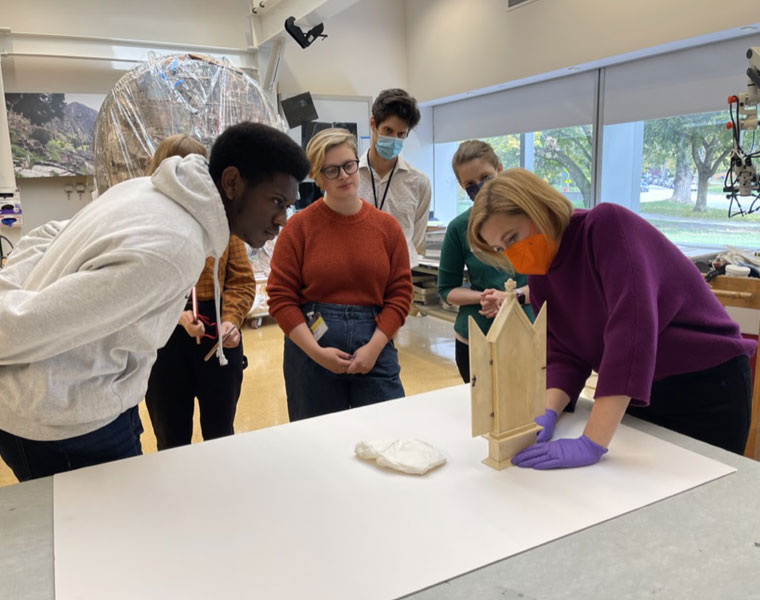The study of medieval art is flourishing at Case Western Reserve University. Among the latest developments: a Microsoft HoloLens Immersive Realms application that allows students to experience medieval treasures as their first owners might have done, and a new medieval student group that hopes to bring medievalists across the university together.
Immersive Realms was conceived by Elina Gertsman, professor of medieval art in the Department of Art History and Art, and one of this year’s Interactive Commons (IC) Fellow. It is being brought to fruition by several partners across the university and the Cleveland community, including IC, Sears think[box], and Cleveland Museum of Art (CMA).
So far, the Microsoft HoloLens, a wireless holographic headset that blends the digital world with the real world, has allowed students at the university to experience a mixed-reality space of a Gothic chapel filled with interactive medieval objects from the CMA.
The project also involves using an Artec Leo 3D Scanner to scan a medieval ivory triptych, the process overseen by the conservator Colleen Snyder and her colleagues at CMA. The acquisition of the scanner was helmed by Elizabeth Bolman, chair of art history and art, and made possible by Tim O’Brien, a longtime supporter of the College of Arts and Sciences.
A full-color, full-scale model of an ivory triptych is now being printed out at think[box]. Using the HoloLens, the IC plans to project the scan onto a physical object held by students, giving them the opportunity to examine the intricacies of the triptych with their own eyes and hands.
“It was incredible to be able to handle the medieval ivory and study it close-up,” said third-year PhD student Reed O’Mara who co-wrote the original IC proposal with Gertsman. “Having this intimate and hands-on experience with the object gave me a greater appreciation of the carving techniques employed by medieval artisans to craft it.”
Rebekkah Hart, a first-year PhD student who did some background research on architectural settings for the app, said: “Being able to touch objects in the same way as they were intended is a dream for any medievalist. I feel so lucky to be one of the researchers helping make that a reality!”
Cecily Hughes, another first-year doctoral student, was given the opportunity, along with others in Gertsman’s Medieval Materialities seminar, to be one of the early testers as the project moved into its mixed-reality phase.
“The chance to make medieval objects more accessible, and therefore more understandable and exciting, to a wide array of people is something I can take with me,” she said. “I want to teach medieval art history at the college level, so the opportunity to experiment with and shape this technology into a better teaching tool is very important.”
Medieval studies for the university community
Last academic year, students in the art history and music departments founded the Graduate Association of Medieval Studies (GAMS). Among the founding members was fifth-year PhD student Sam Truman, who said their goal was not only to unite medievalists across campus, but also to make connections across departments.
The organization holds regular events that are open to all, including reading circles, workshops and book clubs—and this year, they even cooked up a medieval feast, and organized CMA tours. A thriving Julius Fund Lecture series in Medieval Art, exciting courses taught by Gertsman and Bolman, and an extraordinary collection of medieval art at the CMA add intellectual fuel to their efforts.
“GAMS aims to connect medievalists (as well as those who study medievalisms) to foster a sense of community on campus and promote interdisciplinary thinking and scholarship,” said O’Mara. “When we share ideas, which we often do, we become better students and scholars.”
Gertsman, a recent recipient of two Diekhoff awards in teaching and in mentoring, who was recently honored by the Medieval Academy of America’s Award for Excellence in Teaching, is proud of the accomplishments of her students—and their drive to pass along a legacy for medieval studies at the university.
“It is remarkable how much we achieved in a few short years,” she said. “I feel utterly humbled to teach this extraordinary crowd!”
That crowd included Angelica Verduci, who just defended her dissertation and is preparing for her next chapter after Case Western Reserve.
“I am grateful for every art history course I taught, every CMA tour I led,” Verduci said,” and every networking opportunity with other scholars and curators.”
Find out more about joining and participating in future GAMS events, and discover the Department of Art History and Art.

